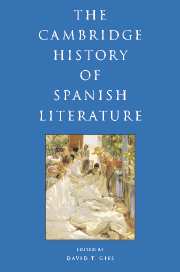Book contents
- Frontmatter
- I INTRODUCTION
- II HISTORY AND CANONICITY
- III THE MEDIEVAL PERIOD
- IV EARLY MODERN SPAIN: RENAISSANCE AND BAROQUE
- 7 Renaissance and Baroque: continuity and transformation in early modern Spain
- 8 Religious literature in early modern Spain
- 9 Renaissance poetry
- 10 The antecedents of the novel in sixteenth-century Spain
- 11 Miguel de Cervantes
- 12 The making of Baroque poetry
- 13 The development of national theatre
- 14 Lope Félix de Vega Carpio
- 15 Pedro Calderón de la Barca
- 16 Didactic prose, history, politics, life writing, convent writing, Crónicas de Indias
- V THE ENLIGHTENMENT AND NEOCLASSICISM
- VI THE FORGING OF A NATION: THE NINETEENTH CENTURY
- VII THE MODERN, MODERNISMO, AND THE TURN OF THE CENTURY
- VIII TWENTIETH-CENTURY SPAIN AND THE CIVIL WAR
- IX IN AND OUT OF FRANCO SPAIN
- X POST-FRANCO SPANISH LITERATURE AND FILM
- Bibliography
- Index
- References
11 - Miguel de Cervantes
from IV - EARLY MODERN SPAIN: RENAISSANCE AND BAROQUE
Published online by Cambridge University Press: 28 March 2008
- Frontmatter
- I INTRODUCTION
- II HISTORY AND CANONICITY
- III THE MEDIEVAL PERIOD
- IV EARLY MODERN SPAIN: RENAISSANCE AND BAROQUE
- 7 Renaissance and Baroque: continuity and transformation in early modern Spain
- 8 Religious literature in early modern Spain
- 9 Renaissance poetry
- 10 The antecedents of the novel in sixteenth-century Spain
- 11 Miguel de Cervantes
- 12 The making of Baroque poetry
- 13 The development of national theatre
- 14 Lope Félix de Vega Carpio
- 15 Pedro Calderón de la Barca
- 16 Didactic prose, history, politics, life writing, convent writing, Crónicas de Indias
- V THE ENLIGHTENMENT AND NEOCLASSICISM
- VI THE FORGING OF A NATION: THE NINETEENTH CENTURY
- VII THE MODERN, MODERNISMO, AND THE TURN OF THE CENTURY
- VIII TWENTIETH-CENTURY SPAIN AND THE CIVIL WAR
- IX IN AND OUT OF FRANCO SPAIN
- X POST-FRANCO SPANISH LITERATURE AND FILM
- Bibliography
- Index
- References
Summary
Cervantes’ Don Quijote was published in 1605. Its immense popularity in Spain, which quickly spread to other European countries – for example, via Thomas Shelton’s (1612) and César Oudin’s (1614) translations of Part 1 into English and French respectively – stimulated Cervantes into adding a second part in 1615. In the seventeenth century, both in Spain and outside, it was generally perceived as a robust, hilarious work of comedy. The coarse continuation of Cervantes’ story by the pseudonymous Alonso Fernández de Avellaneda (dates unknown) (Don Quijote de la Mancha, 1614) typifies the tone. This is not the only way in which, from the viewpoint of posterity, the reactions of Spaniards in this period to this work seem somewhat odd and superficial. Despite scores of imitations of particular incidents in it, or allusions to it, in subsequent literature, the only Spanish writers who systematically treat it as a model of fictional prose-narrative are Avellaneda and Alonso Jerónimo de Salas Barbadillo (1581–1635). In this respect, it would not become a canonical paradigm until the eighteenth century. Moreover, despite the high esteem in which it was held by Spanish men of letters, amongst them great writers like Tirso de Molina and Calderón, it was never quite elevated to classic status, as were the works of Garcilaso, Alemán, Fernando de Rojas, Góngora, Lope de Vega, Quevedo, and Calderón. In a way, Cervantes himself contributes to this result. In the prologue of Don Quijote Part 1, he makes a virtue of playing up his novel’s risibility and popular appeal, and mocks the didactic gravity of contemporary works of literary entertainment – features which, in the eyes of Spanish litterati, redeemed two other masterpieces of comic prose, Celestina and Guzmán de Alfarache.
- Type
- Chapter
- Information
- The Cambridge History of Spanish Literature , pp. 201 - 221Publisher: Cambridge University PressPrint publication year: 2005

